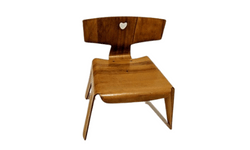 When is a chair just a chair (and not a trademark)? The Trademark Trial and Appeal Board (the “Board” or “TTAB”) recently considered this question in an opinion on whether Herman Miller, Inc. (“Herman Miller”) could claim trademark rights in a famous chair design dating back from the 1940s when Charles and Ray Eames developed a technique for molding plywood and constructing furniture with it (the “Eames Chair”). The image to the left depicts that familiar chair design.
When is a chair just a chair (and not a trademark)? The Trademark Trial and Appeal Board (the “Board” or “TTAB”) recently considered this question in an opinion on whether Herman Miller, Inc. (“Herman Miller”) could claim trademark rights in a famous chair design dating back from the 1940s when Charles and Ray Eames developed a technique for molding plywood and constructing furniture with it (the “Eames Chair”). The image to the left depicts that familiar chair design.
We wrote about “design trademarks” more than 10 years ago in this newsletter but in the context of whether a design trademark can acquire distinctiveness. In that article we discussed how the Carol Hall Shelby Trust failed to claim trademark rights in the iconic shape of the Cobra 427:

The question of whether the race car design was “functional,” however, was not before the Board in that dispute. It has long been held under common law (i.e., not in any statute) that “functional” shapes or features cannot serve as valid trademarks. In 1998, Congress codified the functionality rule (i.e., put it in a statute, the Lanham Act) enabling Trademark Examiners to reject a design trademark or trade dress application on the basis that a design is functional and does not serve as a “source indicator”, which, of course, is the purpose of a trademark. You might ask, what about “design patents?” Rather than applying for a design trademark, one could apply for a design patent. Well, that won’t work either because a design patent cannot protect the functional aspects of a design. The “function of the invention is the exclusive realm of the utility patent” not the design patent as we discussed several years ago in an article on “The Functional Design Patent” in which we explored the difficulty of applying the functionality principle in the design patent context. It is not so straightforward in the trademark context either and the analysis of functionality may actually turn on the existence and content of utility patents.
The Board in Herman Miller wrote that the “ functionality doctrine guards against the ‘misuse’ or ‘overextension’ of trademark protection for product designs” and maintains the balance between trademark and patent law by prohibiting monopolies on designs, thereby inhibiting competition. To determine whether the Eames Chair design was functional, the Board looked to the so-called Morton-Norwich factors, a set of criteria developed in an earlier design trademark case. The factors include:
1. The existence of utility patent disclosing utilitarian advantages of the design;
2. Advertising materials in which the applicant touts the design’s utilitarian advantages;
3. The availability to competitors of functionally equivalent designs; and
4. Facts indicating that the design results in a comparatively simple or cheap method of manufacturing the product
The Board analyzed expired utility patents related to the Eames Chair and concluded that the contoured components of the chair, so important to the applied-for trademark, were also critical elements of the expired utility patents protecting the chair. The Board was not persuaded by Herman Miller’s arguments that the elements of the trademark were “arbitrary, incidental, or ornamental aspects of chair design,” that is, not functional. The Board wrote,
We find the claims and description of the invention in the ‘490 Patent, taken together with the drawings therein, on point with the description and drawing of the proposed mark. The ‘490 Patent indicates that the features of the proposed mark are essential to the use and purpose of the chair, and affect its cost and quality. The patent thus is strong evidence that the matter is functional.
If you are interested in the complete Morton-Norwich analysis performed by the Board, we would urge you to review the original TTAB opinion. Suffice to say here that the Board concluded that the applied-for Eames Chair trademark did not qualify for trademark protection:
When considering the proposed three-dimensional product configuration mark as a whole, the Morton-Norwich factors indicate that it is functional. The patent evidence, the advertisements touting the utilitarian advantages of significant design features of the proposed mark, and the limited availability of alternative designs that would work equally well highlight that the features of the proposed mark affect the cost and quality of the chairs. See TrafFix, 58 USPQ2d at 1006. The proposed mark therefore cannot be registered.
If you have a chair design — or, for that matter, any other design — that you believe may be a great trademark, let us help you determine if it will pass muster with the United States Patent and Trademark Office.
— Adam G. Garson, Esq.

